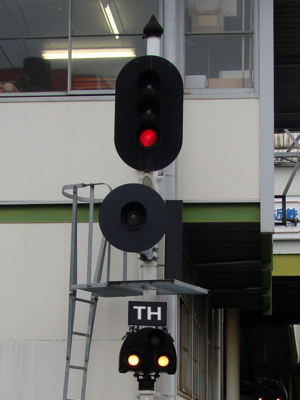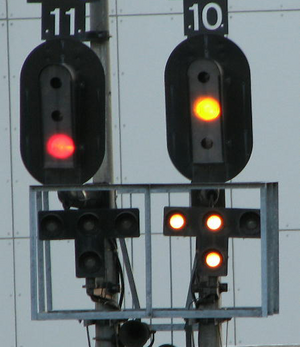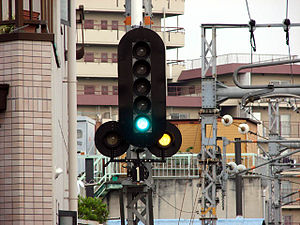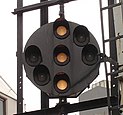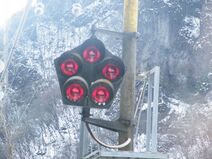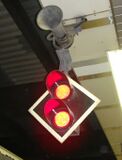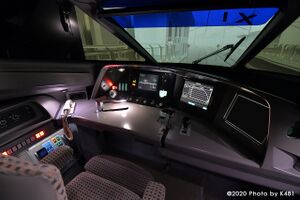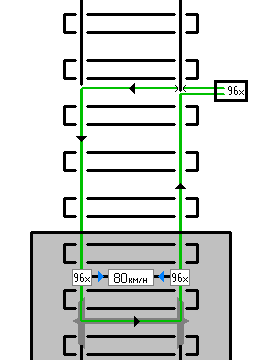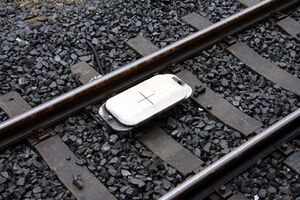Railway Signals in Goyanes
| Please do not edit anything here without the consent of the article's creator. The article's creator is Goyanes (alternate: 20agoyanes). |
Railway signals in Goyanes evolved from electro-mechanical semaphores that changed position to indicate track block status. Before then though, railways employed “track officers” to manage sections of track using hand gestures, line-of-sight techniques, and physical tokens that had to be passed from train to officer and vice versa. This was wildly inefficient, and as the railways grew, technologies were developed to reduce collisions and improve railway safety. Starting with the Grand Trunk Railway and spreading quickly around the nation, electric track circuits that controlled semaphore signals began to take hold. The process started in the 1870s, but by the 1890s, Goyanes’ railway network was fully electro-mechanically signaled.
In 1885, the Stortoghass Tunnel Crash in Gojannesstad occurred, where a through train engineer running a service from the Hysende-Osanhalt-Kongsland Railway onto the grand trunk in Gojannesstad became confused by the Grand Trunk's signal system, and crashed the train, resulting in 30 deaths and more than 50 injuries. This caused the Ministry of Transportation (then known as the Ministry of Railways) to mandate a new, unified, national signal system. The new signal system became known as M-Class signals (M-klassesignalen). M-Class signals used semaphores and relays, and a unified set of meanings. This helped promote inter-operation, and created a stanrdized and safer working environment for the railways.
By the early 1930s, the Ministry of Railways had consolidated all of Goyanes' railways into four companies, the Grand Trunk, the Hysende-Osanhalt-Kongsland, the Nordstrom Seabord, and the Hirendag Road. However in 1921 a fatal accident caused the Ministry of Railways to mandate the four lines to install train protection systems. The system invented by the Grand Trunk Railway and Nasjonalsignalen, ATB, became the most popular, as it provided full cab signalling, and beginning in 1930, was installed on main lines in Goyanes. As color-light signals began to see widespread use during the consolidation era, the system was standardized to fit the ATB system and provide complete unification of teh stafety ststem.
The devolopment of the HHT system in the 1960s and 1970s forced Gojan Jårnbaner, Goyanes' state railway operator, to develop a new cab signalling system. The high speeds of the HHT system prevented operators from being able to see and comprehend any trackside signals, so a system that transmits not just speed like ATB, but track information directly to the driver was created, known as AVK. AVK is currently on its second iteration. In addition, a new system known as ATS-V that uses train-mounted electronics and track-mounted transponders to enforce red signals, confirm yellow and double yellow signals, and stop a train if it is running too fast before a red signal. ATS-V is installed on all classic lines in Goyanes.
Currently in Goyanes, all signals are cab-only or color-light, all classic lines and trains are equipped with ATS-V, and high-speed trains and lines are equipped with AVK.
Fixed Signals
Signals in Goyanes use a combination of route and speed signalling that has evolved over time from the previous semaphore system.
Main Signals
Main signals (Hovedsignalen) are called so because they protect a section of track, known as a block. The main signal protects the entrance to the block of track is guards. There are three types of main signal in Goyanes, starting signals, home signals, and block signals. These three types of signals are governed by two different regimen of signalling practice, automatic block signals and non-automatic block. Automatic block means the block is protected by a simple circuit that detetcts a train inside a block and automatically changes aspcects to block access to that section. When the train leaves the block, the block is automatically opened up again. Non-automatic block means that signals must be lined up by a dispatcher manually ahead of time. Typically interlockings are protected by non-automatic block signals and sections between interlockings are protected by automatic block signals. However, under the non-automatic block system a starting signal has no protected section; it only indicates that all turnouts on the route to the mainline are switched correctly. Under the non-automatic block system trains cannot leave a station without an appropriate token, even if the starting signal is clear. This token is usually a separate light that activates when the stationmaster who controls that block allows the train to pass through the interlocking.
All main signals in Goyanes have between two and six lights, that are either red, yellow, or green. Two-bulb signals may have either green or yellow, but must have red.
The following graphics show main signals. In addition, the main signals shown have the capability of displaying all aspects. In most circumstances, main signals can only display certain aspects that relate to the condition of the lines they protect, and as such could have as few as two lamps, instead of the five pictured here. A note, 5-bulb signals cannot display both high speed clear and restricted aspects. However, 6-bulb signals can display all aspects, in which case the green lamp occupies the top slot. Regardless, the light and color combinations carry the meaning, not the total amount of bulbs on the signalhead.
| Aspect | Name | Description |
|---|---|---|
| High Speed Clear (Hastiket Vortsette) | The high speed clear aspect is used on certain lines when trains become authorized to travel over 130 km/h, as dictated by lineside signs, up to 160 km/h. It is also interlocked with other signals so that there are at least three clear blocks ahead, unlike the usual two that a normal clear signal provides. | |
| Clear (Vortsette) | Proceed at the maximum authorized track speed, or 130 km/h if the track speed limit is higher. There are at least two clear blocks ahead. | |
| Reduction (Verminsken) | The aspect is flashing. It is used to indicate a speed limit of 100 km/h, usually to slow trains down from high speed. There are at least two blocks clear ahead. | |
| Limited (Begrenset) | Displayed when the next signal displays restricted speed (YY) (or caution (Y), in the case of a short block section or poor visbility of the next signal). The speed limit is 60 km/h. There are at least two clear blocks ahead. | |
| Caution (Advarsel) | Displayed when the next signal displays stop. The speed limit is 40 km/h. Sometimes the block ahead may not be displaying stop if the block clears up, but the driver should never expect anything better than stop. | |
| Restricted (Smal) | Displayed when the distance to the next signal is unusually short, another train is running in advance of the signal or the safety overlap at the next signal is shorter than normal. The speed limit is typically 30 kmh. | |
| Stop (Stanna) | Not to be passed. If it is an automatic block signal, non-blocking operation is allowed, where train can continue at a maximum speed of 15 kmh after approval from the dispatcher. |
If a signal lamp burns out, it will automatically switch to the stop aspect. A signal with all lights shut off should be treated as a stop sign unless there is a decomissioning sleeve on the signal, an "X" shaped board on the signal, or if it is turned to the side to face away from the tracks. Additionally, GJ mandates at least two bulbs be off between on bulbs, which is why there ends up being multiple yellow bulbs when there's more than three bulbs on a signal.
Home Signals
Home signals (Hjemsignalen) permit trains to enter the station or interlocking. A home signal is absolute; therefore, non-blocking operation is always prohibited. Some stations have multiple home signals, due to station layout. In these cases, each home signal has an identification number which is counted from the outside of the station. In high-traffic areas, some operators install home signals in the center of a platform track to divide the block section. Some operators treat such signals as block signals. In non-interlocking stations, there may be a No.0 block signal instead. Home signals protecting stations usually have a "TH" plate under the signal, and those protecting interlockings usually have a "KREUSS" plate under the signal.
Starting Signals
A starting signal (Utgangsignalen) permits trains to depart the station, and is an absolute signal. In some stations, there are multiple starting signals due to station layout. In such cases, each starting signal has an ID number which is usually the same as the track number. Some starting signals may also be marked with a plate under the sign reading "US." In non-interlocking stations, there may be a block signal instead of a starting signal.
Block Signals
A block signal (kreissignalen) begins a block section in an automatic-block system. In non-blocking operation a train can proceed past a block signal after stopping for one minute at the signal and contacting teh dispatcher, even if the signal is "stop".
Each block signal is identified by an identification number; as a train travels to the next station or interlocking, the ID numbers count down. The last block signal before the home signal is number one. Each signal is associated with the next one; therefore, it cannot be manipulated by dispatchers or signalmen, unless there is a computerized central traffic system such as in Gojannestad or Naderfjord (ATN). The signal display depends on the presence of a train in advance of the signal and the display of the next signal.
A block signal is a permissive signal, so non-blocking operation is allowed. A train can continue at a maximum speed of 15 km/h after stopping for one minute and contacting dispatch before a block signal displaying stop. The train must not increase speed over 15 km/h until it arrives at the next main signal. Some lines do not require a dispatcher to be alerted before proceeding past a block signal displaying stop, if they have waited for a full minute.
At crowded stations on high-traffic lines, a platform track may be divided into two block sections so a following train can enter the track soon after the preceding train has departed. This signal is known as a No. 0 block signal. GJ treats this signal as a part of its home signals. At non-interlocking stations of GJ, the last block signal before the station is treated as a No. 0 block signal and known as the "home equivalent block signal." This signal is not absolute, since (unlike home signals) non-blocking operation is permitted. On ATN (Automated Train Operation Network) lines in Gojannesstad and other major urban areas, block signals are numbered serially, regardless of non-interlocking stations. In this case, some block signals are defined as home-signal equivalent or starting-signal equivalent using the corresponding plate below the signal.
Call-On Signals
Normally, only one train can enter a block section for safety; however, with this rule a train cannot be coupled with another train. A call-on signal (Spesiellingangsignalen) permits a train to enter a section already occupied by another train to enable coupling.
A call-on signal is installed under a home or shunting signal. The train guided by a call-on signal can proceed under 15 km/h (30 km/h if instructed bt ATB) until it reaches the next train train. In stations where two trains use the same track simultaneously, call-on signals are required to allow two trains on a single block section. However, this is unnecessary if the platform track is divided into two block sections as discussed previously.
When calling-on is allowed, the white lights are activated diagonally. When calling-on is not allowed, the white lights are horizontal.
Route Signalling
As previously mentioned, Goyanes uses a combination of speed and route signalling. The route signalling aspect is mostly seen around interlockings. A signal protecting an interlocking will usually have two signalheads offset and at different heights. The upper signal displays information for the main route, and the lower signals display information for the diverging routes on their respective sides.
Especially when leading into stations or more complex interlockings, the home signal may be preceeded by signals that have two horizontal white lights underneath the signal. These are nown as "advance route setting signals." These show which diverging route is set at the next signal. If both lights are on it means the main route is set, and if only one light is on it means the diverging route is set on the respective side. These signals may also have an electronic board that displays a number, this indicates the track the diverging route leads to inside the station. Number boards are sometimes installed at the home signal as well to emphasize which track the route is leading to.
Due to space constrictions, multiple signalheads may not be available at a home or starting signal, so a more compact "route identifier light" will be placed under the signal. It comprises of white lights arranged in a "T" shape that indicate which direction the diverging routes are set to. When all lights are off it indicates the main route is set.
Shunting/Dwarf Signals
Shunting signals, also known as “dwarf signals” (kleinesignalen), are used for shunting purposes in yards, or for other purposes that do not warrant protection by a main signal. They are smaller in size, and use only white aspect colors. They may be placed on top of a half-height post, or placed at the same height as the trackbed. A shunting signal uses three bulbs to display two different states. When the two horizontal lights are illuminated, the signal is at danger and should not be passed without authorization from dispatch or a yard foreman. When the illuminated lights are diagonal, it means clear, and the train may proceed into the protected section at a maximum of 45 km/h. A "shunting sign" is a permissive form of the shunting signal that has no protected section. It is distinguished from normal shunting signals by using one or more purple bulbs in the aspect.
Repeater Signals
A repeater signal (viegjentasignalen) is linked to a home, starting, or block signal that has reduced visibility or is very far away (to allow proper braking distance). The repeater signal essentially re-broadcasts the aspect of the signal that it's tied to. The signal is position-light, meaning (similarly to shunting signals), the orientation of the illuminated bulbs determines the meaning of the signal. It uses three lines of of three bulbs to communicate its meaning. A vertical line indicates the signal is clear, a diagonal line indicates the signal is showing some sort of cautionary aspect, and a horizontal line means the signal is at danger. Some repeater signals in more dangerous locations have ATS-V transponders linked with them that command an aknowledgement when a repeater is passed showing a caution or stop aspect.
A special type of repeater signal may be used to indicate the "high speed clear" status which involves using a second repeater signal head above the main one that can only display proceed. When both are showing proceed, it indicates the signal is showing high speed clear. In addition offset repeater heads may be used to show the status of a main signal with diverging routes ahead.
Emergency and Obstruction Signals
Emergency signals (nødfallessignalen) are used to signal an imminent danger ahead of the train. Presently, there are two types of signals used interchangeably around Goyanes to indicate to train drivers that there is an emergency or obstruction ahead (e.g. car stalled on tracks or person fallen onto tracks) and that the driver must make an effort to stop before the obstruction or emergency. This includes applying the emergency brankes if neccessary. Modern sensors on railroad crossings can detect stalled vehicles and automatically activate the emergency signal. Others may be activated by pull handles on platforms or near railway crossings. The old style emergency signals display their aspects by rotating two lit red lamps around the pentagonal shape. The new style simply uses the two lit red lights as its aspect, and may also have a buzzer attached to it.
AVK System
The AVK system was invented in 1959 and inplemented in 1964 for use on HHT high-speed services, as operators would not be able to read and interpret lineside signals at high speed. AVK-1 was the first iteration of the system invented, with the second and current iteration being known as AVK-2. Signaling information is instead transmitted to the train and displayed as part of the train controls. The driver is shown the safe operating speed, displayed in kilometers per hour. The late-1990s-developed AVK-2 system transmits more information than traditional signalling would allow, including gradient profiles and information about the state of signaling blocks much further ahead. This high degree of automation does not remove the train from driver control, although there are safety mechanisms that can safely bring the train to a stop in the event of driver error or incapacitation.
History
The AVK system was developed by Gojan Jårnbaner engineers in conjunction with the Nasjonalsignalen company, which currently markets the system worldwide. The system was based off of ATB, a proven system that has been installed on conventional lines since the 1930s. The AVK-1 system went online in the first section of the HHT system to open, the Gojannnesstad-Naderfjord high-speed railway.
AVK-1 was a relay-based system that used rigid blocks, and communicated with the train using pulse codes sent to the train based on the signal state. The pulse codes are sent theough the front axle of the train as it bridges the circuit across the two rails, and the pulse code is interpreted by a sensor on the train, which otputs a maximum permitted speed based on the track limits and the block status ahead. In this aspect it is extremely siilar to ATB. However, as the train slowed down, the rigid block system caused an uncomfortable braking experience, which required lowering speed, then easing off the brakes, then braking harder again. This, among other things, prompted the development of AVK-2.
By 1999, the engineers decided to improve the AVK system with new microprocessors both onboard and trackside, and a new, more computerized trackside system. The new system was called AVK-2. AVK-2 was marketed by Eindrisson engineers as part of a multi-tiered approach. AVK-2 would be standard operation (cab signalling and automatic train protection from overspeed and stop signals), AVK-2.1 (optional automatic train control), and AVK-2.2 (fully automatic operation).
In 2010, the AVK system was applied on certain classic lines to test throughput capacity. It proved successful and now, certain very-high capacity lines have had the AVK-2 system installed to increase frequency of trains.
Implementation
In AVK-2, the track is dotted with transponders mounted in the center of the track every usually 200m to 1 km (in some schenarios they can be as close as 10 meters, such as at where a side track joins a main line). The sections of track block are guarded by transponders at both ends, but there are usually transponders inside the track block as well. The track block uses a standard track circuit to detect the position of a train. Lineside equipment stations transmit the last updated distance to the next train to the train via the transponder, as well as the maximum permitted line speed.
There is a main equipment box that controls about 10 blocks, which in turn is controlled by the central control room for that line. The central control room is able to integrate the AVK-2 system with the scheduling system to maintain precise headways, and ensure safety of operations.
Onboard the train, as it passes over a transponder, the distance to the train ahead, maximum line speed, and track gradients are recieved, and this information is sent to the onboard computer, which determines a braking curve using the given information and known information such as train acceleration and braking performance. The computer then displays an authorized speed on the dashboard. The authorized speed is constantly being recalculated, as the train estimates its position to the train ahead, and along the line (for gradient purposes) using the onboard odometer. The distance is confirmed/reset every kilometer when the train passes over a transponder, which subsequently updates the train on its current position.
When the train reaches the point where the computer determines it should begin braking, or if it passes a transponder and an updated speed is given, an alarm sounds in the cab which the operator must confirm. Then the braking curve begins. The operator should brake normally, but keep an eye on the speedomoeter, as the speed limit decreases in real time. If the speed of the train exceeds the maximum authorized speed, either while cruising or braking, the train will apply brakes to bring it below the authorized speed. The continuously dynamic braking curve drastically improves passenger comfort, and allows for closer headways. Once the authorized speed stops decreasing, a bell sounds in the cab.
The signalling system is permissive; the driver of a train is permitted to proceed into an occupied block section without first obtaining authorisation. An occupied block section is indicated on the speedometer by a speed limit of 30 km/h. When the speed limit is 30 km/h, the train cannot exceed 32 km/h, and must stop before any obstructions, track defects, or trains ahead. Non-permissive blocks, such as at entrances and exits to stations, and at interlockings, are marked with an orange, diamond-shaped, board with a black cross. There will always be a transponder protecting the block, as well as a dwarf signal. These are the only color/light signals on AVK-protected tracks. If a driver encounters a non-permissive board, they must do two things. First, they must check the speed indication. If it is not 30 kmh, they may proceed as normal. If 30 km/h is given, they must look at the dwarf signal at the non permissive sign, if it displays stop, they must stop before the board, and if it displays proceed or proceed with caution, they can pass the board. Entering a non-permissive block at danger will trigger an emergency brake application. Non-permissive blocks can also be guarded by a single color-light, as is the case on newer tracks. If the section is protected, a red light will illuminate. GJ has been swapping the dwarf signals for color lights since 2010 as they offer improved visibility.
The additional information passed along by the transponders can concern a variety of events or actions, such as signal system changes at the entry or exit of a high-speed line, arming or disarming the AVK-2 system, closing air vents before entering a tunnel at speed, raising and lowering the pantographs, or changing the supply voltage at system barriers. When trains enter or leave the high-speed line from classic lines, they pass over a ground circuit which automatically switches the driver's dashboard indicators to the appropriate signalling system. For example, a train leaving the high-speed line onto a classic line would have its AVK signalling system deactivated and its traditional ATS (automatic train stop) and ATB (automatic speed control) systems activated by the train's onboard computer at the boundary point.
Oversight
A "black box" similar to an aircraft flight data recorder, passively watches over the entire process, monitoring a variety of parameters and recording the events onboard the train. In AVK-2-equipped trainsets, older paper-strip recording equipment has been replaced by a digital recording system. Every action taken by the driver (throttle, brakes, pantographs, etc) as well as signalling aspects (for AVK-2, and conventional signals (via the ATS and HBK signals) are recorded on magnetic tape for later analysis using a desktop computer.
Another system, known as FK, oversees the driver's alertness. The FK system is located in the brake handle. The handle itself is a button, and when the handle is pressed down, the train can operate. The FK system asks the driver to release and depress the brake handle every 60 seconds if there has been no input to the train's controls. The timer resets every time there is an action. If the handle is released, there is a grace period of about 15 seconds before an alarm sounds. If the alarm sounds for 10 seconds, the emergency brakes are applied.
A small amount of overspeed allowance is allowed before the AVK system will activate the emergency brakes. For 30 km/h the tolerance is 2 km/h. Below 80 km/h, the tolerance is 5 km/h. Between 80 km/h and 160 km/h it is 10 km/h. At speeds in excess of 160 km/h, it is 15 km/h. If the speed is in the tolerance speed, an overspeed warning buzzer sounds, and is not deactivated until the speed goes below the limit speed again. If the speed exceeds the safety tolerance the buzzer switches to an alarm and the brakes apply to bring the speed within the tolerance. If the driver does not aknowledge the alarm and safety braking after 5 seconds of braking, the emergency brakes will activate and the train will be stopped. The alarm does not switch off until the train comes to a complete stop.
Cab Display
In the centre of the driver's desk in an HHT cab, or on any other AVK-equipped train, just below the windscreen, there is the speedometer. The permitted speed is showed in a bar over the actual speed, as well as on a numerical readout next to the speedometer. As the braking curve is enforced, the speed limit bar decreases in real time, allowing the driver to adjust his braking rate accordingly. All the in-cab signalling displays must be very reliable, since they are critical to safety. The coded software is safety-critical, and enforces that the current aspect being displayed to the driver is correct. If there is a failure in the display unit, appropriate action is taken to stop the train.
AVK-2 has extensive redundancy built into it, and one might wonder why it is not used to control the train directly. However, keeping in mind the lack of adaptability of the system to unexpected situations, it is considered desirable to retain a human in the loop. Driving an HHT is therefore done entirely manually, but the signalling system keeps a very close watch to ensure maximum safety.
Conventional Cab Signalling (ATB System)
Most main railway lines in Goyanes are equipped for cab signaling using the ATB (Atomatisk TogBeinnlflytelse; Automatic Train Supervision) system, with the exception of the HHT lines (AVK is used instead). ATB was installed beginning in 1930 on the main line of the Grand Trunk Railroad after a 1925 Ministry of Railways mandate that required automatic train protection systems after a fatal accident in Madelein, Osanhalt in 1921. Nasjonalsignalen and Eindrisson developed competing systems, but ultimately the Nasjonalsignalen one was used.
Operation of the ATB system is as follows: a 100 Hz (and in lines equipped for travel at or above 140 km/h a 250 Hz overlaid) AC voltage is applied to the rails. The voltage is switched on and off at various frequencies (known as the pulse code) which can be decoded by the train. The circuit of the track current loop is closed by the leading axle of the train, causing a magnetic field to be created around the rails. Two coils mounted ahead of the axle, usually behind the snowplow, pick up the magnetic fields, converting them into electrical signals read by the ATB equipment onboard.
Overspeeding is permitted within 5 km/h of the set speed. When this happens, an overspeed light turns on. If a train accelerates faster than 5 km/h above the ATB-set limit (doesn’t apply when braking to a new lower speed limit), an alarm will sound, and the overspeed light will begin to blink. If the driver does not commence braking within 3 seconds of the alarm starting, ATB will engage the emergency brakes and cut traction power. Once the train has stopped completely, the ATB system can be unlocked, the alarm will shut off, and the train can proceed again.
When a speed limit change occurs a chime sounds. When the speed limit is lowered, and the train is travelling faster than the new limit, the driver must begin braking within 5 seconds. If not, the ATB system will begin an emergency stop. If the braking rate is not sufficient an chime will sound, and a light labeled “Brake Demand” will turn on, indicating the driver must brake harder. If more braking is not applied in 5 seconds, once again, the emergency brake and associated alarm will activate, and the “brake demand” light will blink. The alarm will silence once the train is within the mandated braking rate.
Once the train has slowed to the new speed limit, the Limit Reached Chime will sound twice, and the “limit reached” light will momentarily turn on, indicating that the train is now locked into the lower limit and that the normal overspeed protection is active again.
The signal system is split into blocks, however each block is usually split into at least two ATB circuits. This allows ATB to allow drivers to slow down before a caution signal (which enforces a 40 km/h speed limit), for example. In addition, having multiple circuits per block allows speed limits defined by track geometry (i.e. curves) to be announced ahead of time so drivers can slow down. Because the ATB system uses continuous transmission of information, when a signal ahead clears up resulting in a speed limit raise, the driver is instantly notified (unlike AVK which transmits information at periodic intervals when the train passes over a transponder). This allows for closer train headways and higher punctuality.
The premise is that the ATB system will inform the driver of (as well as enforce) the maximum speed along that section of track, and the traditional signal system will inform the driver of the status of the track ahead. ATB is linked to and controlled by the signal system, so ATB will automatically create slowdown buffers in front of restrictive signals as well as clear up as signals clear. ATB does not waive the driver from his responsibility to be paying attention to signals, ATB simply makes the signal system more comprehensive and efficient.
ATB can also prevent starting against orders of a red signal. When the 0 ppm code is given, this translates to a 0 km/h speed limit, therefore ordering the train to stop before the signal mast. If the train tries to pass the signal while it is still red, they will not be allowed to increase past 5 km/h without activating the emergency brake. If a signaller has opened the shunting signal to allow trains to be coupled, a 25 ppm code will be sent through the tracks, allowing a 30 km/h speed limit to be used for shunting operations.
The 147 ppm code is known as the standby code. When a train exits an ATB-protected area, the train passes over a short section with 147 ppm code that automatically places the unit onto a standby mode. The system will essentially be offline until it detects a 147 ppm code (or any pulse code for that matter) upon entering a new track area, at which point it will automatically activate again. The ATB onboard computer can be manually brought in and out of standby mode as well.
Here is a guide to the various speed codes used by ATB:
| 100 Hz Code | 250 Hz Code | Cab Signal Speed |
|---|---|---|
| 0 | -- | 0 km/h |
| 25 | -- | 30 km/h |
| 50 | -- | 40 km/h |
| 75 | -- | 60 km/h |
| 96 | -- | 80 km/h |
| 120 | -- | 90 km/h |
| 147 | -- | Standby Code |
| 180 | -- | 100 km/h |
| 220 | -- | 120 km/h |
| 270 | -- | 130 km/h |
| 420 | -- | 140 km/h |
| 270 | 270 | 150 km/h |
| 420 | 420 | 160 km/h |
Automatic Train Stop (ATS-V)
ATS-V (Automatisk TogStanna-Vægr; Automatic Train Stop-Transponder) is a transponder-based train protection system that was invented in 1970 and installed nationwide beginning in 1974 after a deadly 1967 accident in Heidekerby, Nyhett during a blizzard in which an engineer passed a signal at danger since he did not see the signal, resulting in the train crashing head on with a train stopped in the station. The system not only prevents running a signal at danger, but also serves to stop the train ahead of a red signal if it is going too fast to stop, and to require confirmation from the driver when passing a yellow or double yellow signal. Previously, some lines used automatic train stop systems that relied on track-mounted tripcocks and train-mounted anglecocks, and continue to be used on certain railways, such as the Gojannesstad U-Baner.
ATS-V makes use of inductive coupling between a transceiver mounted on the train and a passive transponder mounted on the track that oscillates at preset frequencies when activated by the magnetic field from the aforementioned transceiver. The transponders require no outside power, however there is a cable that is connected to the signal equipment to control small relays inside the transponder which switch capacitors in/out of the coil circuit and determine which frequency is detected by the passing train.
Each transponder is offset from the centerline of the track as they are directional. The transponders are mounted at 5 meters before the signal, 15 meters before the signal, and at 400 meters before the signal (less if the block is short). The 5-meter transponder serves the signal confirmation function and the signal passing at danger function. When a train passes the 5-meter transponder and the signal is yellow or double yellow it will sound a chime and turn on a light, requesting a confirmation button press. If the button is not pressed within 3 seconds of the chime the emergency brakes will be applied and the alarm will activate. If the signal is red, passing the 5-meter transponder will automatically trigger the emergency brakes. Passing the 5-meter transponder with a green-yellow, green, or double green aspect will a small green “ATS OK” light to momentarily switch on.
Even though ATB limits the speed of trains within blocks with yellow signals, when trains run on lines without ATB or if ATB malfunctions a train could potentially run up on a red signal with excess speed, unable to stop short of the signal. To fix this, (usually) 400 meters before the signal there are a pair of ATS-V transponders spaced .5 meters apart. When the train passes over the first transponder a speed check is initiated. The onboard component of ATS-V is programmed with the time it should take between transponders at 65 km/h. If the time is too short between transponders (meaning the speed is more than 65 km/h), the emergency brakes will be applied in order to bring the train to a halt before the signal is passed at danger (or if it is passed, the train will not stray as far into the next block). If the second transponder is not detected in 5 seconds, the speed is assumed to be permissible. There is another additional pair of speed timer transponders placed about 15 meters before the signal calibrated to 20 km/h that has the same function as the 400 meter pair.
If the train is stopped due to overspeed before a red signal, an “Overspeed ATS” light will turn on and an alarm will activate, which will not shut off until the ATS-V system is unlocked once the train comes to a stop.
The frequencies and their meanings are as follows: 60 kHz - Proceed; 64 kHz - Speed Timer Start; 68.3 kHz - Speed Timer End; 88.5 kHz - Confirm cautionary signal; 95.5 kHz - Stop; 99.3 kHz - Error.
Here is a guide to the oscillation frequencies used by ATS-V:
| Oscillation Frequency | Meaning |
|---|---|
| 60 kHz | Proceed |
| 64 kHz | Initiate Speed Check |
| 68.3 kHz | End Speed Check, Start Calculation |
| 88.5 kHz | Confirm Cautionary Signal |
| 95.5 kHz | Stop |
| 99.3 kHz | Error |










